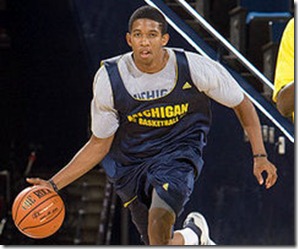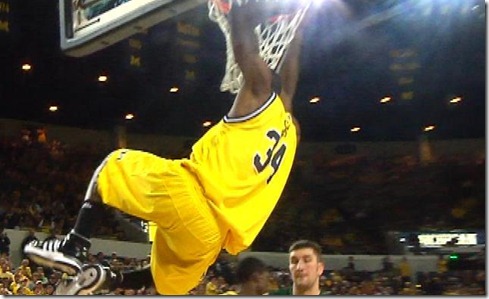As we near the regular season opener, here are six questions that appear to be relevant to Michigan’s performance this year. I’d love to hear some thoughts and answers in the comments as well as other questions you may have.
Are the freshmen guards the real deal?
Zack Novak, Stu Douglass, and Laval Lucas-Perry played crucial roles in Michigan’s 2008-2009 campaign. Without contributions from the freshmen, Michigan almost certainly would have been sitting at home in March.
This year there are four incoming freshmen: Darius Morris, Matt Vogrich, Jordan Morgan, and Blake McLimans. At this point, it’s hard to imagine Morgan, who is recovering from a knee injury, or McLimans being a significant contributor. On the other hand, the opportunity is there for Morris and Vogrich.
Morris appears destined to start at the point guard position (more below) while Vogrich has one of the sweetest strokes on the team. They aren’t without their issues. I address Morris’ concerns more below but the biggest question for Vogrich is whether he can get by athletically at this level. He can definitely shoot it but if his defense and athleticism are sub-par that’s going to keep him off the court.
What can Michigan get out of the point guard position?
Manny Harris has a point guard-esque assist rate and John Beilein doesn’t rely on a true point guard in his two guard offense but Michigan needs more production out of the point guard position than last year.
CJ Lee, Dave Merritt, and Kelvin Grady manned the point guard position last year. Here are their numbers in conference play:
| Player | MPG | PPG | eFG% | ORtg | Usage | APG | Ast Rate |
| Lee | 20.33 | 2.83 | 47.7 | 112.3 | 10.5% | 2.11 | 21.4 |
| Grady | 17.23 | 3.94 | 51.8 | 104.1 | 15.6% | 1.882 | 23.7 |
| Merritt | 10.44 | 1.28 | 54.7 | 92.3 | 10.1 | .833 | 16.5 |
Obviously there is not a lot of production from these three. They were the three most invisible players in the Michigan offense in terms of the number of possessions that they used. They shot a high percentage, made the easy assists, but they didn’t have a huge influence on the game.
Darius Morris appears to be the starter at the point from day 1. Physically he is a better player than last year’s point guards. The question is how fast can he pick up the offense and adjust to the pace of division 1 basketball.
Will DeShawn Sims stay inside or float to the perimeter?
DeShawn Sims made a dramatic improvement between his sophomore and junior seasons. He went from an inefficient three point shooter to an inside-outside threat that had a legitimate case to make first team all conference.
A man much smarter than me, John Gasaway in the CBP Preview, pointed out the dramatic improvement that DeShawn Sims made in his 2 point field goal percentage last year. Sims hit 55% of his two point shots last year while posting the highest shot percentage (percentage of his teams shots while he was on the floor) in the conference (30.7%).
Sims shot 32% from three point range last year and it seems unlikely that he will improve much upon that number. He did take significantly fewer three pointer attempts last year. There has been lots of talk about Sims playing more on the perimeter this year, but I’m really not sure that is something that will help Michigan.
Sims needs to get his touches inside on the block as well as from around 15 feet where he can hit the jumper consistently. I have no problem with Sims taking a few threes, but last year’s DeShawn Sims was much more productive than the perimeter Sims the year before.
Can Michigan continue to be a solid defensive rebounding team?
Michigan was actually a very good defensive rebounding team throughout conference play. Their 71% defensive rebounding percentage ranked them third in the conference, only behind Michigan State and Wisconsin. They even rebounded Michigan State to a draw in their lone meeting.
Manny Harris rebounds his position extremely well with a 19.2% defensive rebounding percentage and DeShawn Sims is solid on the glass. They will have to keep this herculean effort up in order to keep Michigan’s rebounding numbers respectable.
In terms of help from other positions, most of the candidates have a blaring negative. Zack Novak is a good rebounder but he’s obviously at a disadvantage size-wise. Zack Gibson has never been much of a rebounder, focusing more on trying to block shots. Darius Morris has good size for the point guard and could provide a boost, however he’s still a point guard that will spend his time on the perimeter.
Offensive rebounds are not very important in this system, and defensive rebounds can be overcome, but Harris and Sims’ rebounding numbers will be critical.
Will we see more 1-3-1 zone?
The zone has obviously been a staple of John Beilein’s teams for years however over the last two seasons we have only seen it in limited doses. Last year Michigan even went to a 2-3 zone down the stretch to shore up their defense.
The 1-3-1 zone is designed to force turnovers at the expense of giving up some easy looks at the basket. When the zone isn’t creating turnovers, it is rendered worthless because it is almost assuredly going to still give up easy looks.
Here is a breakdown on how many turnovers Beilein’s teams forced over the passed six seasons.
| John Beilein Defense Turnover % 04-09: | |||||
| 04 | 05 | 06 | 07 | 08 | 09 |
| WVU | WVU | WVU | WVU | U-M | U-M |
| 21.8% | 22.9% | 24.5% | 23.8% | 20.5% | 20.8% |
Every single John Beilein West Virginia team forced more turnovers than either of his teams at Michigan. Michigan’s ability to force turnovers has been mediocre at best but perhaps this is the year where the 1-3-1 zone really clicks. One obvious means of improvement is Darius Morri
s’ length at the top of the 1-3-1 zone which should definitely help Michigan force more turnovers.
Can Michigan continue to improve behind the arc, not only on offense but defense as well?
It all comes back to the three point shot. Michigan is going to take a ton of three point shots and they are going to have to make them. I’ve already posted some thoughts about three point shooting on the offensive side of the ball but what about defense?
Last year Michigan not only shot the ball better than the year before, they defended the three point line very well. After allowing opponents to shoot 38.1% from three point range in Beilein Year 1, opponents only shot 31.4% (35th nationally) in year 2.
With Michigan’s lack of size down low they are going to struggle defending the two point shot, their 49.9% last year ranked 246th in division 1. However, it’s possible to make up for this by defending the three point shot. I think this is one of the most critical often overlooked statistics.












